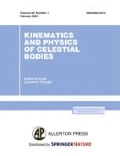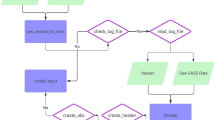Abstract
The current state of the research activities of the Main Astronomical Observatory of the National Academy of Sciences of Ukraine (MAO NASU) on the use of GNSS technology is presented. Today, MAO operates a permanent GNSS network consisting of five stations (two stations are temporarily inactive). All stations are included in EPN and the EPOS network, GLSV, KHAR, and UZHL stations are also integrated to the IGS network. MAO Operational Centre also provides automatic data transfer from 12 stations installed by other Ukrainian organizations included in the international networks. Data from approximately 300 Ukrainian permanent GNSS stations are stored in the MAO Local Data Centre. The MAO Local Analysis Centre uses Bernese GNSS Software for different types of data processing of GNSS observations. Rapid processing is performed on a daily basis for monitoring the stability of the permanent stations from some Ukrainian RTK networks. All available observations data from the Ukrainian stations for the period from December 7, 1997, to January 28, 2017, were processed according EPN standards during the MAO’s second reprocessing campaign and regular processing. As a result, the coordinates in the IGb08 reference frame and tropospheric zenith delays for 233 permanent stations (202 of them are the Ukrainian stations), as well as the velocities for the 128 stations that have observation period more than 3 years, were estimated. The creation and development of local GNSS networks, as well as the long-term filling of databases with high-precision coordinate solutions and estimates of the displacement velocities of GNSS stations, made possible to conduct geodynamic studies at the local level. The strain ellipses and rotation were found based on estimated coordinates and velocities of the GNSS stations. In 2016–2019, Kharkiv National University of Radio Electronics, in cooperation with MAO NASU, performed a number of studies on high-precision GNSS positioning and navigation. New implementations of modern methods and algorithms for the PPP positioning were created and experimentally tested. The errors of the daily floating PPP solutions were 5…8 mm (with a probability of P ≈ 95%) for static mode and 5…8 cm (P ≈ 68%) for kinematic mode. The decimeter/centimeter error of determining the coordinates of current satellites with low Earth orbits (LEO) in the implementation of kinematic floating and fixed PPP solutions was proven. The development of a high-accuracy multiposition phase system of trajectory measurements for field tests of high dynamic aircrafts (HDA) were proposed. The estimated values of the root-mean-square error (RMSE) in determining the HDA motion variables were in the range from 0.05 to 0.40 m for coordinates and from 0.5 to 1.6 cm/s for the velocity vector components.








Similar content being viewed by others
REFERENCES
V. Verkhovtsev, New Platform Geostructures of Ukraine and the Dynamics of Their Development, Doctoral Dissertation in Geology and Mineralogy (Inst. of Geological Sciences of the National Academy of Sciences of Ukraine, Kyiv, 2008) [in Ukrainian].
A. A. Zhalilo, A. I. Dokhov, E. V. Katiushina, E. M. Vasilieva, A. I. Yakovchenko, and O. A. Lukyanova, “Development of a high-precision system for determining the trajectories of spacecraft and other high-dynamic objects,” Prikl. Radioelektron. 16, 112–116 (2017) [in Russian].
M. I. Orlyuk and M. V. Ishchenko, “Comparative analysis of modern deformation and the newest motions of the Earth surface in the territory of Ukraine,” Geofiz. Zh. 41 (4), 160–180 (2019) [in Russian]. https://doi.org/10.24028/gzh.0203-3100.v41i4.2019.177381
O. Khoda, “Estimation of coordinates of the Eastern European permanent GNSS stations in the IGb08 reference frame for GPS weeks 1709–1933,” Kinematics Phys. Celestial Bodies 35, 46–53 (2019). https://doi.org/10.3103/S0884591319010045
O. Khoda, “The second reprocessing campaign of historical observations in the GNSS data analysis centre of MAO NAS of Ukraine,” Kinematics Phys. Celestial Bodies 36, 243–252 (2020). https://doi.org/10.3103/S0884591320050050
Ya. S. Yatskiv, The Everyday of Science. The “Coordinate-and-Time Support” Case (Akademperiodyka, Kyiv, 2008) [in Ukrainian].
M. Ishchenko, “Investigation of deformation of the earth crust on the territory of Ukraine using a GNSS observations,” Artif. Satell. 53, 117–126 (2018). https://doi.org/10.2478/arsa-2018-0009
O. Khoda, “EPN densification project: Report of the Main Astronomical Observatory NAS of Ukraine,” Presented at the EUREF Analysis Centres Workshop, Brussels, Belgium, Oct. 25–26, 2017.
O. O. Zhalilo, O. I. Dokhov, and O. I. Yakovchenko, “Multi-positional phase system of trajectory measurements and experimental confirmation of its accuracy using GPS-observations of the Ukrainian reference stations,” in Aerospace Technologies in Ukraine: Problems and Prospects: Proc. 3rd Sci.-Pract. Conf., Kyiv, Sept. 12–13, 2019 (Nats. Tsentr Upr. Viprobuvan’ Kosm. Zasobiv, Kyiv, 2019), pp. 105–106.
A. Zhalilo and A. Yakovchenko, “Development of PPP-method realization for low earth orbit satellite trajectory determination using on-board GPS-observations,” East.-Eur. J. Enterp. Technol. 5 (9), 33–40 (2016). https://doi.org/10.15587/1729-4061.2016.81026
O. O. Zhalilo and O. I. Yakovchenko, “LEOS trajectory determination using the on-board GPS-observations and PPP-technologies of their processing,” in Aerospace Technologies in Ukraine: Problems and Prospects: Proc. 3rd Sci.-Pract. Conf., Kyiv, Sept. 12–13, 2019 (Nats. Tsentr Upr. Viprobuvan’ Kosm. Zasobiv, Kyiv, 2019), p. 107.
Author information
Authors and Affiliations
Corresponding author
About this article
Cite this article
Yatskiv, Y., Khoda, O., Ishchenko, M. et al. The Research Activities of the Main Astronomical Observatory of the National Academy of Sciences of Ukraine on the Use of GNSS Technology. Kinemat. Phys. Celest. Bodies 37, 96–105 (2021). https://doi.org/10.3103/S0884591321020069
Received:
Revised:
Accepted:
Published:
Issue Date:
DOI: https://doi.org/10.3103/S0884591321020069




